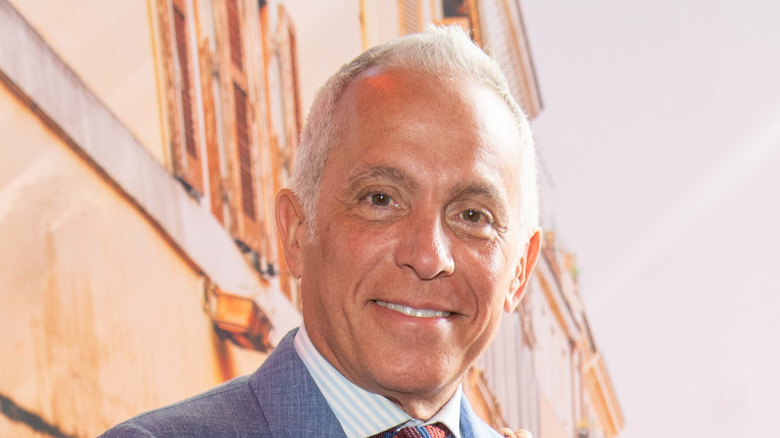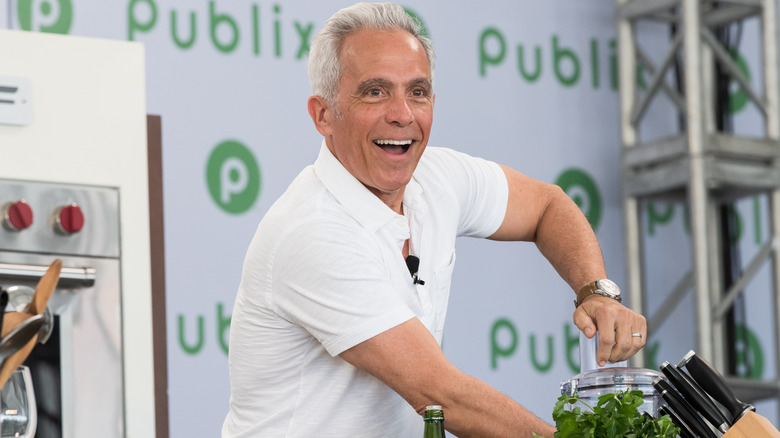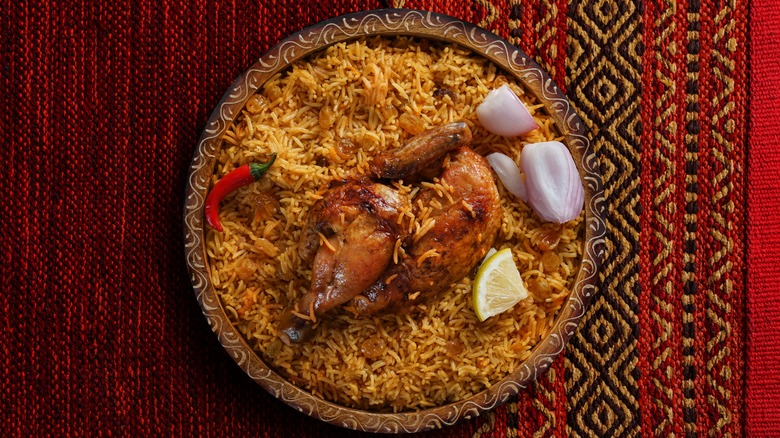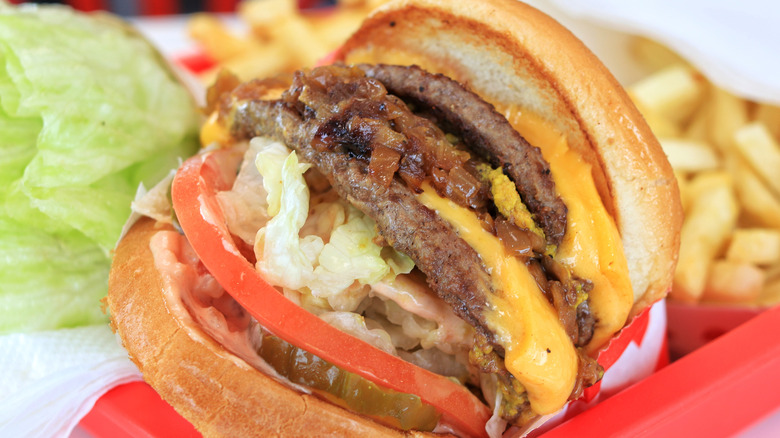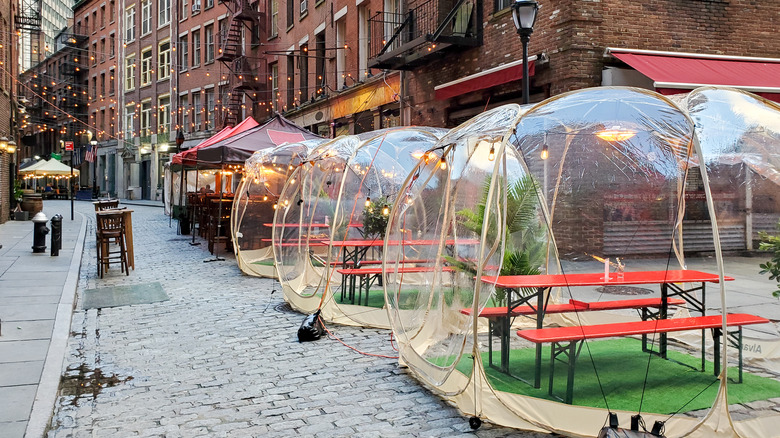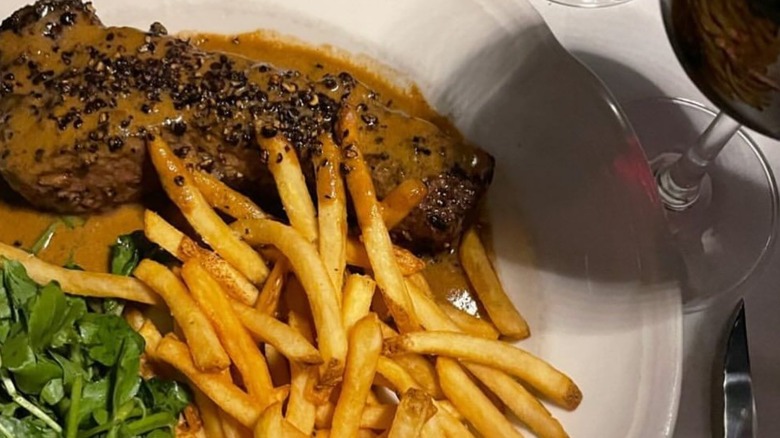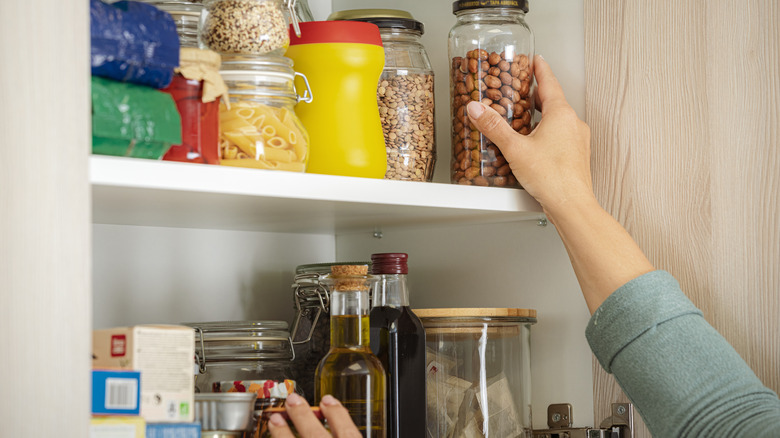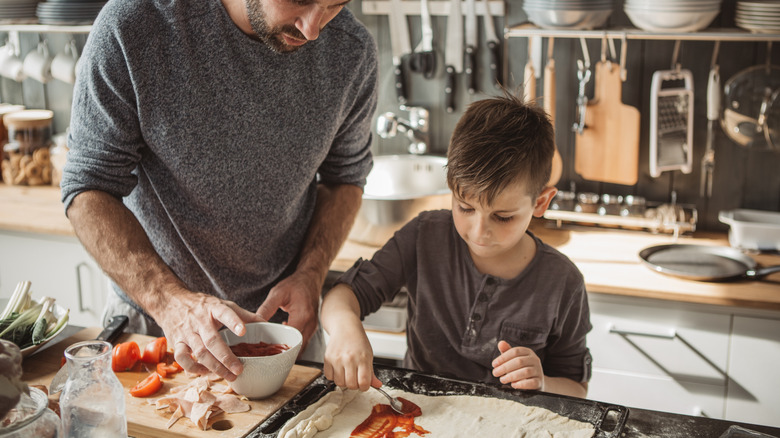For Geoffrey Zakarian, Breakfast Is The Best Time To Connect With Your Heritage - Exclusive Interview
Geoffrey Zakarian is no stranger to the dining environments of major metropolises like New York and Los Angeles. This March, he'll join a collection of national and local chefs as a marquee talent for the first iteration of a new L.A. Wine & Food Festival. Although he has quite a list of places he'd like to visit in the City of Angels, Zakarian isn't shy to admit that he expects to have to lean on his network of friends to find out where the newly minted hot spots are located.
Recently, Tasting Table caught up with the chef for an exclusive and wide-ranging interview in which Zakarian gave us everything from insights about what he'll be bringing to the festival to the ways he infuses his kids' breakfast with the flavors of his Armenian heritage. As a notable figure in the world of food and media, Zakarian is always a good voice to have at the table, no matter if the discussion is covering his favorite fast-food cheeseburger or the ever-evolving dining scene in New York.
Geoffrey Zakarian at L.A. Wine & Food Festival
We at Tasting Table are curious: What can attendees look forward to from you at the upcoming L.A. Wine & Food Festival?
Well, it's new. This is a whole new world, L.A. Food Festival. It sounds completely ridiculous that it should be new, because L.A. is such a fantastic food world, but it's sort of a new look for us. We do a lot of food fests ... I know what people like. But I also know that stuff that I like that is maybe a touch more esoteric or fun that I think people will appreciate. And I try to do it in a classical sense always, I always try to have one foot very much in the past.
And so I was wondering ... First of all, I don't know what the weather's going to be in LA. I know it's kind of not very good right now, but usually, it's pretty nice. So I'm figuring it'll be in the 60s or 70s, and since we're going to be outside on the pier, I decided to do fish. How about that? Radical.
Any particular insight into what type of seafood you're going to be using or how you're going to be using it?
Probably a bluefin tuna from the Akami. And I want to put maybe an Italian spin on it. I'm not quite 100% sure what the finished product's going to be, but when we get there, we'll see. It always depends on when you do these things, what the setup is, and what you can do outside. And there's so many people, there's so many moving parts, it's like opening a pop-up for two hours. I plan for the best, but I plan for the worst also. I'm going to put an Italian sort of condiment spin on it. It's not going to be a tartar. And I might use some caviar just because caviar is seemingly making a comeback.
Isn't it?
Seems to be. It was luxury, and oh my god, poo-poo, and now it's like, "Oh, caviar with toast and eggs." It's become okay because now there are very many offshoots; since they banned some caviars, a lot of other caviars have come by that aren't so expensive and so dear. They're excellent. So that's what I'm thinking.
We have some great chefs going. You saw the lineup. It's also great. I've contacted Antonia [Lofaso], and I'm like, "Please tell me where to go for dinner." I don't know anyone. It's just so much, it's like chock full of choices. She's going to give me a list of where to go.
Finding Armenian food in Los Angeles
As you mentioned, in L.A., it's such a big city, so it seems really interesting that this is the first iteration of this L.A. Wine & Food Festival. I'm really curious about what some of your go-to restaurants are around the city.
You know who I call? I call Simon Majumdar. I don't know if you know Simon? He's a judge on "Iron Chef" with me and he's on Food Network as well, and he lives in L.A. He's originally a food writer. He has his pulse firmly on what's good and what's not good in California. He's eaten at every place there is.
So I'll go see maybe Chef Funke, because he's amazing. And where else will I go? Trying to go to Bicyclette because I haven't been, and I have such respect for those guys. And maybe République if I can. Musso & Frank Grill, the old style. I like old-style stuff. Maybe Craig's, because I used to always go to Craig's and say hi to him and always end up staying and having a bite to eat.
And then I'm going to wait for Antonia. She's going to give me a list and Simon's going to give me a list, so I'm excited for the new stuff. I read all about it, but then it's just so much stuff. If you're in New York and L.A., you need three lives.
Carrying on a little bit in that vein; L.A. has the largest population of Armenians in the country. Do you have any recommendations for eating Armenian cuisine in the city?
I wish I did. Sadly I don't. And I know there is someplace good and I know it's probably in Manhattan Beach or it's in some strip mall, you know what I mean? Because that's usually where the best restaurants you don't know about are. But I'm going to find out now. Now you asked that question, I'm going to ask Simon.
Armenian food for breakfast
How about Armenian dishes? Let's say you're cooking at home. Do you have any particular dishes from the cuisine, tips, and tricks that you could recommend for preparing them?
We do eat a lot of rice. Instead of cooking it in a casserole like my mom used to cook it, we cook it in a rice cooker, a Japanese rice cooker. And so we always try to do that. And when you flavor rice, it's really interesting. So we try to flavor it with fresh bay leaves and things like that. I use a lot of lamb here, but I still love lamb.
And we eat ground lamb for breakfast. We grind the lamb with some onions, we sweat it in a lot of butter, and then we add cinnamon and pine nuts and we do a nice flatbread on the side and scrambled eggs. And so you just put the eggs, the ground lamb that's buttery and brown and cinnamony, and pine nuts as sort of like a crumble. Just dip the eggs on your pita or flatbread and you put the lamb on top and eat that for breakfast. It's like an Armenian taco tapas. It's so delicious, and no one puts together cinnamon and pine nuts and lamb, but that sort of really embodies what Middle Eastern cuisine is. It's very simple, but it's incredibly fragrant.
So a lot of coriander, a lot of cinnamon, a lot of star anise. It has roots or parallels to almost Vietnamese flavorings, but it goes deep into butter and lamb and eggplant, tomato, a lot of rice dishes, and a lot of lamb and beef that's dried. We're very deep in flavor and warm spices. And it's sort of a cuisine that's very inexpensive for the most part, but that's sort of what we concentrate on in this particular house. I have a lot of flavor profiles. I have three young kids, so we're all over the place. It's not just one sort of flavor profile.
Thanks for sharing that. Now my mouth is watering.
The breakfast is delicious, and my kids go nuts when I have it. My kids' favorite breakfast is olive tapenade, which I make. I get grilled French bread on a planchette that I bake in the morning from frozen. And I put out slices of prosciutto, provolone, tapenade, fresh bowl of arugula, and they make their own sandwich in the morning, and they grab that, and they get in the car, and we take them to school. Who would've thought that it would be like that, but it's perfect. You have protein; you have olives, anchovies, and capers. You have good fermented stuff, nice French bread, you have beautiful greens, and you have great fat and protein. I mean, that's what your brain needs as a human being in the morning.
In-N-Out versus Shake Shack
So, speaking of something nice and fatty, maybe not necessarily in the healthiest direction: Are you an In-N-Out or Shake Shack guy?
Oh, In-N-Out, animal style.
All right, interesting to hear that.
Shake Shack, Danny [Meyer]'s a friend, but he loved In-N-Out before he did Shake Shack, let's be honest. It just shows you that you can have something that isn't quite as good as the original, but then it's wildly successful, and it's 10 times the size as the original. 20 times, 30 times. But the original is the original. The O.G. is the O.G.
And I guess the beautiful thing about being a traveling chef is you don't have to pick.
Nope. All I do when I come to cities is I call up a chef I know in the city and I'm like, "tell me where to go." I have 90 minutes to eat. And they tell me where to go; that's the best barometer. Or Simon, Simon's actually great because he knows. He's the L.A. expert. That's the best way. You've got to really ask someone who dines on their day off where they go.
NYC Dining four years post-pandemic
A more serious question: As such a prominent figure in the New York dining scene, I'm curious to know how you feel about the city's foodscape approaching four years post-pandemic.
I'm there all the time because I film there. At least in New York, I have many points of light, so I'm never at a loss where to go. It seems quite vibrant to me. There's been a shuffling. It's like musical chairs, and not in a bad sense.
You get to a point where you're so saturated with restaurants, which New York was in 2018. You are going to get to a point where there is a supply of people who want to work in the food industry versus the expense, which is rising very rapidly, versus the amount of people that can afford it. You have a changing landscape of more fast casual, less formal, and fewer overall restaurants.
What's happened in New York is that office space has diminished. It's a devastating number for lunch and for catering and for after-parties. You've lost, I don't know the number, I'll say close to 5,000 restaurants.
What's happened is you have had sort of this fallback with fewer restaurants. Food and drink are very expensive now. I don't know the last time you've been in New York City, but it's really gone up to a large level. You have people that are doing very well, like the Daniel Boulud Group, Jean-Georges Group, and a few others that have established themselves and have very good leases because they've been in the city for a long time. When people want something, and they can depend on someone, you have [restaurateurs] that can have a specialty restaurant, and [customers] are around once in a while, and it's fun to go for a special occasion. Now people say, "Okay, they've been around 30 years; let's just go there."
That's what they call a default restaurant. The people I mentioned are great restaurateurs, but they're also great default restaurants. If you can't find a place to go and you can't get into ZiZi, or you can't get into whatever the new places are downtown, can't get into Jody Williams', Jean-Georges is close by, just go there. Let's go to JoJo. Or let's go to The Cafe.
That's what's happened. It's like the more specialized [restaurateurs] have gotten bigger and a wider array of restaurants, but there's definitely been a shrinkage in the industry as a whole. I don't know the feeling, but I do ask questions when I'm there, and they do tell me the landscape is so difficult now as far as expense-wise. Yet it's thriving as always. Places like Le Bernardin have never been busier in their livelihood. You have this extreme of business and this quality that's still, to me, the best in the country.
Making a steak au poivre
Speaking of NYC and specific dishes, steak au poivre seems to be having a moment there. Do you have any tips for preparing it at home? Do you prefer to keep it classic? What's your take on this?
Steak au poivre ... it's so funny, Raoul's in the Village, it's like 40 years old. It's an old French dump, but when you walk in you're, it's just so perfectly French. It's like if there was a Hollywood set and they say, "French bistro in the Village," this would be it. They've had a steak au poivre there for 40 years. I moved to New York in '83, and I still remember the taste of it. It's about the sauce, the quality of the meat, and the cut of the meat.
It's normally a New York strip, which is a sirloin, a center cut because the end cut tends to have too much intermuscular fat, which doesn't dissolve when you cook it. You have chunks of stuff you can't chew. And you just really have to know timing; it's all timing. You have to cook it, get a really good sear on it.
People put so much pepper, cracked pepper, that it's really off-putting. First of all, if you put so much pepper on a steak and you sear it, it gets bitter. Secondly, when you eat that pepper steak, if it's just cracked pepper, your mouth's going to burn in not a nice way, and you're going to choke on those pieces of peppercorn.
You really need to understand that a traditional pepper steak has pepper on the outside, but really green peppercorn is the base of the sauce. It's not all just cracked black pepper. You have to have the right sear, shallots, butter, a little cream, some really good beef stock, flambé with a little brandy, and then green peppercorns in combination with the black pepper and a touch of butter at the end. Reduce it so you have this beautiful glaze; you put the meat back in after you sear it and just one or two turns, and you let it go. But it's got to rest in the sauce for a second because if you cut it unrested, all the blood from the inside of the steak will look weird on the sauce.
It's usually served on a platter on the side so you can look at it. You should never cut a steak au poivre in the kitchen. You let it sit, and you give it whole; you get the customer to get a knife and cut it. It just ruins the mouth feel if you slice it and fan it out. It should never be done. It's not like a sliced duck breast. Obviously, the unifying side of fries is never on the same plate. It should be steak au poivre sauce and then fries on the side, and mayonnaise or ketchup, whichever you prefer. I prefer mayonnaise.
Staples for your pantry and bar
Some underrated pantry staples that you think home chefs should always keep on hand?
That's a fun question. I'll tell you stuff that I think everybody should have; I just mentioned it: tapenade. Whether you buy it or make it, you should have a tapenade. You should have pickled onions. You should have a sambal oelek, like a beautiful spicy chili sauce. You should have miso paste, Pommery mustard, Worcestershire sauce, and Tabasco sauce.
Those are sort of wet and cold pantry items. Then, on the dry side, cinnamon, star anise, whole cardamom, and whole cloves. I'll give you canned anchovies and canned Portuguese tuna.
How about non-negotiable ingredients that mixologists should include within their bar?
Non-negotiables? Well, I'll go on the non-booze side. You've got to have a couple of beautiful bitters. You should have two or three kinds of simple syrup, maybe a honey simple syrup and a regular simple syrup. Those are real backbones. Definitely three or four Amaros so you can make some beautiful Amaro cocktails and bitters, Italian Amaros.
Then I go for real good London dry gins, two or three, not too many. I'm not into a lot of the new gins because they're often flavored. It's fun to have a couple of bottles of fun-looking gin, Gunpowder gin, and those kinds that are sort of quite good. Hendrick's, it's fun to look at that bottle, but it tastes like cucumbers. I'm a Plymouth gin drinker. I think Plymouth and Beefeater are two really good London dry gins. Two vodkas, a whiskey, a bourbon, a Japanese scotch, a scotch from Islay.
And then, I mean, it's up to you what you want to add to that. Definitely really good vermouth, a red vermouth, a white vermouth, Noilly Prat. Some Castelvetrano olives and some fantastic cherries in brandy. And you basically have a bar that pretty much will suit anyone. Some nice Fever-Tree products, mixers, soda, tonic, ginger, quinine.
A bar is relatively simple. It's the thing when you get all this esoteric stuff, most people don't have room for all this stuff, right? So you really have to understand, "Okay, well, what is it that I'm going to be good at?" You should be good at an Aperol spritz, you should be good at a Manhattan, you should be good at a nice whiskey sour, and you should be good at a martini. If you get those, anybody can make a margarita, anybody can have vodka and tonic, gin and tonic, but you want to be good at those four. And those four things I just mentioned don't take a lot; it's not a heavy lift to have those on your bar.
Cooking with your kids
You have the cookbook, "The Family That Cooks Together." What's your advice for home cooks who are looking to get their kids involved in the kitchen?
That's a good question. Well, for my kids, I mean, I'm in the kitchen all the time. So if you're in the kitchen, it's a natural place for them to be next to you because they love to be next to you. And I think the kitchen is the most important gathering place in the house. It always has been. What's made it better is that it used to be that the kitchen was here, and then it was a wall, and then there was another room, and then that was the dining room, and there was a wall and another room, and that was the living room. But now the open plan is like a kitchen, counter, family room. Even in apartments, it's kitchen, counter, living room, right? So the kitchen is actually the hub of activity now, it always was, but now there's no wall. When you're in the kitchen, you're in the living room. When you're in the living room, you're in the kitchen. So it's just a natural place to be.
So they'll wander behind the stove, and when you're cooking, you just ask them simple things. I always start with breakfast because it's the first thing you eat. Put them on the counter like, hey, help me crack some eggs. Help me whip this, help me whisk this, help me do this. And they watch you, they pay attention. Kids are observant. Even though they're four feet, they can't quite see it, they're observant. And they understand, they can see the smoke, they can see the spattering of oil, they can see the steam coming up. They can smell the butter burning, they can smell the bacon burning. So they understand when they come down, they can smell, "Are you making pasta?" Because they can smell the sauce that's on.
That's everything. As soon as they smell and see and feel and hear, it's tactile, it's ambient, right? It's like music almost. They'll come in there like, "Dad, what are you doing?" You're like, "Good, you want to help?" They'll say yes. That's everything. You don't have to force them. That is not the way to do it. And give them a little bite that's delicious. All my kids, they cook. My daughter, she's like, "Get out of the kitchen, Dad. I got it." She doesn't even want my help.
It started with just the breakfast in the kitchen and the living room and the gathering place, it's all the same thing. It's always been that way, but now architecture has really given us this sort of opportunity to teach the kids.
The L.A. Wine & Food Festival is March 1-3, 2024. You can purchase tickets here.
